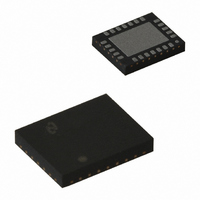LM4873LQX National Semiconductor, LM4873LQX Datasheet - Page 16

LM4873LQX
Manufacturer Part Number
LM4873LQX
Description
IC AMP AUDIO PWR 3W STER 24LLP
Manufacturer
National Semiconductor
Series
Boomer®r
Type
Class ABr
Datasheet
1.LM4873MTEXNOPB.pdf
(25 pages)
Specifications of LM4873LQX
Output Type
2-Channel (Stereo) with Stereo Headphones
Max Output Power X Channels @ Load
3W x 2 @ 3 Ohm; 440mW x 2 @ 8 Ohm
Voltage - Supply
2 V ~ 5.5 V
Features
Depop, Input Multiplexer, Shutdown, Thermal Protection
Mounting Type
Surface Mount
Package / Case
24-LLP
Lead Free Status / RoHS Status
Lead free / RoHS Compliant
Other names
*LM4873LQX
Available stocks
Company
Part Number
Manufacturer
Quantity
Price
Company:
Part Number:
LM4873LQX
Manufacturer:
ROHM
Quantity:
2 029
www.national.com
Application Information
microprocessor, or a microcontroller. When using a switch,
connect an external 10kΩ pull-up resistor between the
SHUTDOWN pin and V
SHUTDOWN pin and ground. Select normal amplifier opera-
tion by closing the switch. Opening the switch connects the
SHUTDOWN pin to V
HP-IN FUNCTION
Applying a voltage between 4V and V
HP-IN headphone control pin turns off Amp2A and Amp2B,
muting a bridged-connected load. Quiescent current con-
sumption is reduced when the IC is in this single-ended
mode.
Figure 3 shows the implementation of the LM4873’s head-
phone control function. With no headphones connected to
the headphone jack, the R1-R2 voltage divider sets the
voltage applied to the HP-IN pin (pin 16) at approximately
50mV. This 50mV enables Amp1B and Amp2B, placing the
LM4873 in bridged mode operation. The output coupling
capacitor blocks the amplifier’s half supply DC voltage, pro-
tecting the headphones.
The HP-IN threshold is set at 4V. While the LM4873 operates
in bridged mode, the DC potential across the load is essen-
tially 0V. Therefore, even in an ideal situation, the output
swing cannot cause a false single-ended trigger. Connecting
headphones to the headphone jack disconnects the head-
phone jack contact pin from −OUTA and allows R1 to pull the
HP Sense pin up to V
tion, turns off Amp2A and Amp2B, and mutes the bridged
speaker. The amplifier then drives the headphones, whose
impedance is in parallel with resistor R2 and R3. These
resistors have negligible effect on the LM4873’s output drive
capability since the typical impedance of headphones is
32Ω.
Figure 3 also shows the suggested headphone jack electri-
cal connections. The jack is designed to mate with a three-
wire plug. The plug’s tip and ring should each carry one of
the two stereo output signals, whereas the sleeve should
carry the ground return. A headphone jack with one control
pin contact is sufficient to drive the HP-IN pin when connect-
ing headphones.
A microprocessor or a switch can replace the headphone
jack contact pin. When a microprocessor or switch applies a
voltage greater than 4V to the HP-IN pin, a bridge-connected
speaker is muted and Amp1A and Amp2A drive a pair of
headphones.
SHUTDOWN
Logic High
Logic Low
Logic Low
Logic Low
Logic Low
PIN
DD
TABLE 1. Logic Level Truth Table for SHUTDOWN, HP-IN, and MUX Operation
DD
DD
. This enables the headphone func-
through the pull-up resistor, activat-
. Connect the switch between the
DD
Logic High
Logic High
Logic Low
Logic Low
HP-INPIN
(Continued)
to the LM4873’s
X
16
MUX CHANNEL
SELECT PIN
ing micro-power shutdown. The switch and resistor guaran-
tee that the SHUTDOWN pin will not float. This prevents
unwanted state changes. In a system with a microprocessor
or a microcontroller, use a digital output to apply the control
voltage to the SHUTDOWN pin. Driving the SHUTDOWN pin
with active circuitry eliminates the pull up resistor.
SELECTING PROPER EXTERNAL COMPONENTS
Optimizing the LM4873’s performance requires properly se-
lecting external components. Though the LM4873 operates
well when using external components with wide tolerances,
best performance is achieved by optimizing component val-
ues.
The LM4873 is unity-gain stable, giving a designer maximum
design flexibility. The gain should be set to no more than a
given application requires. This allows the amplifier to
achieve minimum THD+N and maximum signal-to-noise ra-
tio. These parameters are compromised as the closed-loop
gain increases. However, low gain demands input signals
with greater voltage swings to achieve maximum output
power. Fortunately, many signal sources such as audio
CODECs have outputs of 1V
the Audio Power Amplifier Design section for more infor-
mation on selecting the proper gain.
Logic High
Logic High
Logic Low
Logic Low
X
FIGURE 3. Headphone Circuit
(MUX INPUT CHANNEL #)
Single-Ended Amplifiers (1)
Single-Ended Amplifiers (2)
OPERATIONAL MODE
Micro-Power Shutdown
Bridged Amplifiers (1)
Bridged Amplifiers (2)
RMS
(2.83V
P-P
). Please refer to
10099324











